Northrop Crew – Assigned 754th Squadron – May 1944

Kneeling: Frank Deimel – N, Henry Northrop – P, Dee Jack Butler – CP, Thomas Jeffers – B
Shot down June 18, 1944 – MACR 5908
| Rank | Name | Serial # | Pos | Date | Status | Comments |
|---|---|---|---|---|---|---|
| 2Lt | Henry H Northrop | 0813561 | Pilot | 18-Jun-44 | POW | Stalag Luft III |
| 2Lt | Dee Jack Butler | 0761871 | Co-pilot | 18-Jun-44 | POW | Stalag Luft III |
| 2Lt | Frank C Deimel | 0712777 | Navigator | 18-Jun-44 | POW | Stalag Luft III |
| 2Lt | Thomas F Jeffers | 1698015 | Bombardier | 18-Jun-44 | POW | Stalag Luft III |
| S/Sgt | Lawrence E Dean | 34509333 | Radio Operator | 18-Jun-44 | POW | Stalag Luft 4 |
| S/Sgt | Harold J Flaugher | 35791387 | Flight Engineer | 18-Jun-44 | KIA | Ardennes American Cemetery |
| Sgt | Jack J Gonzales | 39276036 | Ball Turret Gunner | 18-Jun-44 | POW | Stalag Luft 4 |
| S/Sgt | Joseph F Risko | 36578141 | Airplane Armorer-Gunner | 05-Nov-44 | CT | Completed 30 Missions |
| Sgt | Alexander Cardenas | 38367896 | Waist Gunner | 18-Jun-44 | POW | Stalag Luft 4 |
| Sgt | Charles D Clifford, Jr | 39693927 | Tail Turret Gunner | 18-Jun-44 | POW | Stalag Luft 4 |
The Northrop crew was assigned to the 754th Squadron at the end of May 1944. Their time with the 458th was short lived. They flew their first combat mission to bomb the airfield at Evreux/Fauville in France on June 12th. Their second mission was flown two days later on the 14th. Their target was the rocket emplacement (No Ball site) in Domleger, France. On this mission Sgt Joseph Risko suffered frostbite and was hospitalized for several days, as Risko recalled later, “My heated suit went out on me and I froze both my ears, right hand, and my left shoe had a short which slightly burned my foot. I was put in a hospital ward and grounded for six days”. On June 17th, Northrop’s crew was scheduled to hit the airfield at Bourges, but the mission was scrubbed.
On June 18th the crew took off in Rhapsody In Junk to hit the airfield at Fassberg, Germany. On this flight, the 754th’s Armament Officer, 1Lt William J. Brodek, assigned himself as a waist gunner on Northrop’s crew. The Continent was overcast that day which prevented the lead aircraft from locating the target. Passing Hamburg, the 458th started taking heavy anti aircraft fire. Rhapsody In Junk took hits in the number one and number four engines which soon became useless. Flying on only two engines, there was no way to maintain their position in formation and they were forced to drop out and head for home. Orders were given to get rid of all excess weight and the bombs were jettisoned. One of the bombs, which had been armed, still hung in the bomb bay. Co-pilot Dee Butler, with the use of a length of rope, lowered bombardier Thomas Jeffers, and he was able to kick the bomb out.
After a short time number three engine failed and the crew realized they wouldn’t be able to stay in the air much longer. Nearing Kiel the crew came under intense anti aircraft fire again which put additional holes in the aircraft. Miraculously none of the crew had been wounded. Northrop hit the bail out bell and the crew began to depart. S/Sgt Harold Flaugher, a tall man, was terrified of jumping, fearing that his parachute would not hold him. Butler, realizing that time was growing short, pushed Flaugher out the open bomb bays and then followed him out.
All ten men left the plane and all ten chutes opened. The officers were quickly rounded up by the Germans and loaded into a truck which contained a black wooden coffin. They were taken to a nearby warehouse where they were directed to a covered body laying on the floor. Even though S/Sgt Flaugher’s chute had opened, he did not survive the jump. The four officers noted that he had a heavy bruise on his right temple and his chest was crushed. Since Butler had seen Flaugher’s open chute, they believed that he had been killed either by striking some structure in his decent to the ground or by incensed German civilians after he had landed. Their belief in the latter was strong enough to initiate a war crimes investigation after the war into Flaugher’s death, but no one was ever brought to trial.
With Flaugher being so fearful of jumping, it is very likely that he pulled the ripcord immediately upon leaving the ship, causing the chute to open prematurely and propel him into one of the B-24’s low twin rudders. The blow to his head and chest would have killed him instantly, but if this is what truly happened is not known. The four officers were directed to remove Flaugher’s personal effects and place his body in the coffin. The rest of the crew along with Lt. Brodek was soon brought in and they all climbed aboard the truck and took Flaugher’s body to a nearby German military cemetery where they were told to leave their friend for burial.
The officers and enlisted were eventually split up with the officers sent to Stalag Luft III and the enlisted to Stalag Luft IV, there to spend the next ten months as prisoners of war.
Sgt Joseph Risko, still recovering from frostbite, did not accompany the crew on the June 18th mission. He flew the remainder of his missions with several other crews. Risko completed his tour on November 5, 1944.
————————-
MACR 5908
Six crews report LT NORTHROP left formation in vicinity or NEUMINSTER, GERMANY at approximately 1020 hours. He made a 180 degree turn and headed east. Only visible reason for action was smoke from #1 engine. He was last seen under control entering undercast. One crew reported hearing A/C believed to be #733 calling for Air Sea Rescue about 1100 hours over North Sea. This report was checked and discounted — as it was another A/C with similar call sign. Last report is that A/C #733 is believed to have made Sweden.
2Lt Thomas F. Jeffers – Bombardier
“On the 17th our crew was assigned to fly in our new plane (#106) to France on a morning mission. The flight was “scrubbed” because of bad weather while we were taxiing out. We had the Squadron Armaments Officer [Lt William Brodek] riding with us because one of our gunners had received a bad case of frostbite, and he wanted to ride along as gunner. Unfortunately, when the mission was called again in the afternoon, Lt. Brodek decided that he didn’t want to go, and as a consequence, Lt. Morley’s crew was sent out in #106 in our place. Morley was lost in #106 and we were lost the next day flying the oldest and most war weary #733, Rhapsody In Junk. Two of our engines quit at once near Hamburg, we lost altitude, were hit by flak at low altitude, lost a third engine and finally had to bail out. Our flight engineer was killed and the rest of our crew spent the rest of the war in POW camps. Some of the enlisted men walked across Northern Germany from 5 February until 8 May 1945 when met by British troops.”
Missions
| Date | Target | 458th Msn | Pilot Msn | Serial | RCL | Sqdn | A/C Msn | A/C Name | Comments |
|---|---|---|---|---|---|---|---|---|---|
| 12-Jun-44 | EVREUX/FAUVILLE | 64 | 1 | 41-28705 | W | Z5 | 32 | YE OLDE HELLGATE | |
| 14-Jun-44 | DOMLEGER | 65 | 2 | 41-29305 | N | Z5 | 20 | I'LL BE BACK/HYPOCHONDRIAC | |
| 18-Jun-44 | FASSBERG A/D | 69 | 3 | 41-28733 | X | J4 | 31 | RHAPSODY IN JUNK | SHOT DOWN FLAK (MSN #1) |
B-24H-10-DT 41-28733 J4 P Rhapsody In Junk

Mid-April 1944 with 15 missions and one fighter destroyed
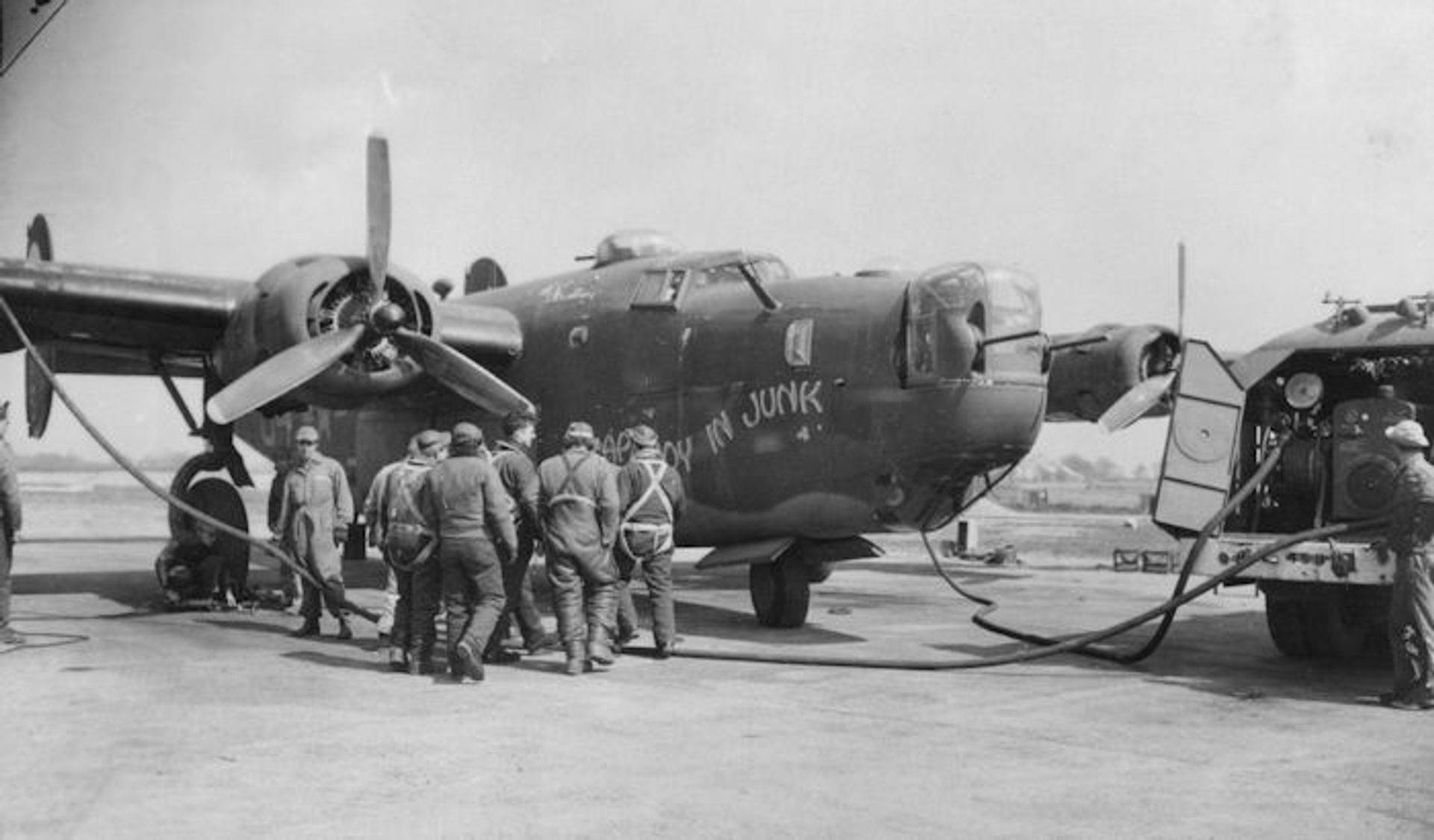
Stephen Davidson Crew of the 753BS getting ready for a mission – April 1944
Diary of Lt. Thomas F. Jeffers – Bombardier
World War II Diary of Thomas F. Jeffers
2nd Lt. A.C in England
Started June 4, 1944
Left the United States on April 27th, 1944 flying as bombardier on crew in B-24 H airplane.
Pilot: Henry H. Northrop – Batavia, N.Y.
Co-pilot: Dee J. Butler – Ogden, Utah
Navigator: Frank Deimel – Chicago, IL
Engineer: Harold J. Flaugher – Bloomdale, Ohio
Radio Operator: Lawrence E. Dean – Kingsport, TN
Armorer Gunner: Joseph Risko – Detroit, MI
Nose Turret Gunner: Alexander Cardenas – Corpus Christi, TX
Ball Turret Gunner: Jack Gonzales – Sacramento, CA
Tail Turret Gunner: Charles E. Clifford – Los Angeles, CA
We left Topeka, Kansas the morning of April 27th arriving in Manchester, New Hampshire at Grenier Field that night. Visited Brockton next night and then flew out of Grenier the morning of the twenty-ninth arriving at Goose Bay, Labrador that afternoon. Stayed overnight at Goose Bay and left next night for Meeks Field, Iceland. Had a nice trip flying over an overcast almost all the way. Had to stay in Iceland for two and one half days due to weather but managed to leave finally & again flew over an overcast most of the way landing in Nutts Corner on Lough Neagh in Northern Iceland on May 3, 1944.
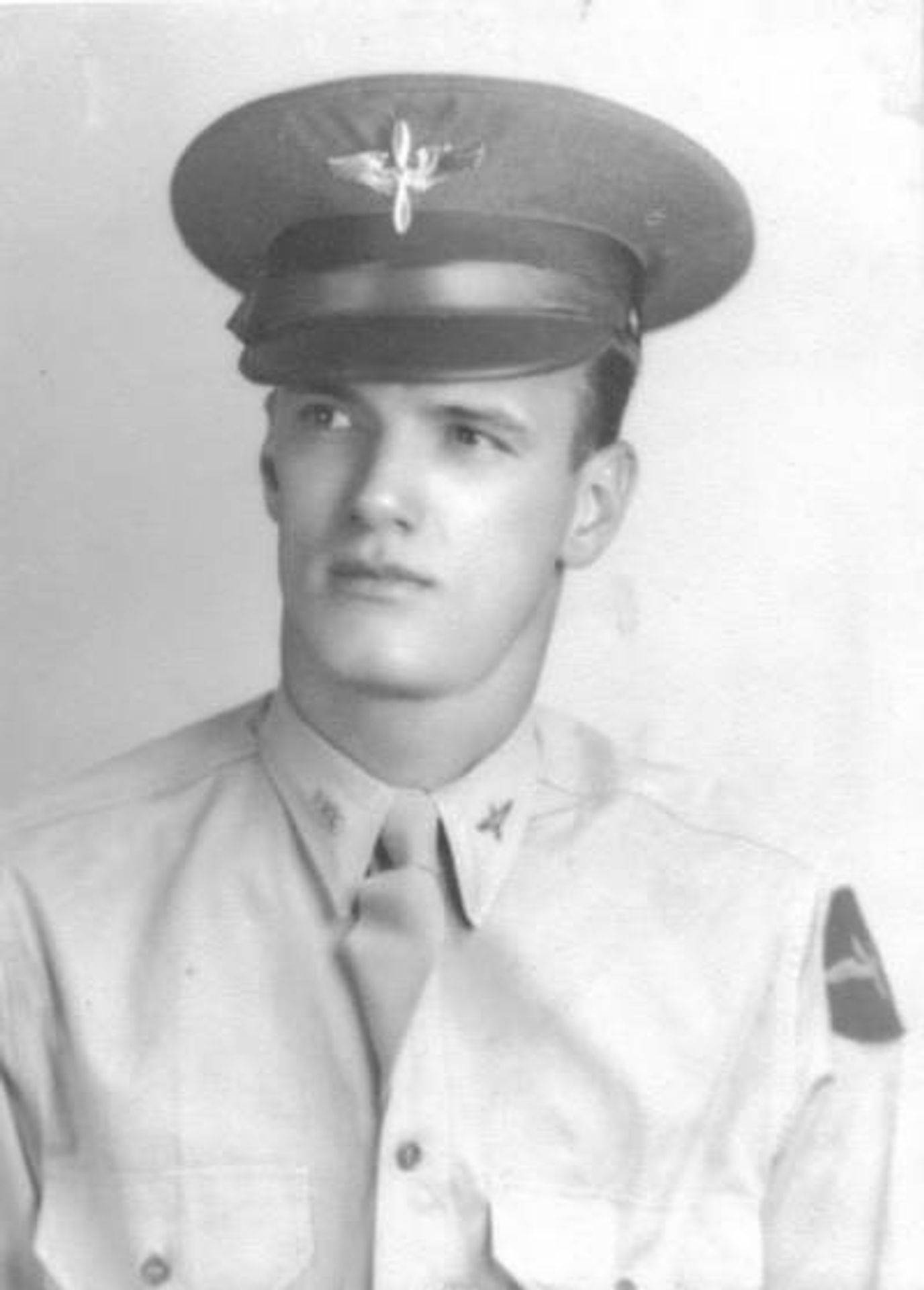
It was on this leg of our trip that a crew went down and I lost one of friends from Big Spring. Bill Carpenter of Marshall, Texas. He went down just short of our goal & within sight of Scotland. It seemed strange in Iceland to have daylight up until about one o’clock in the morning and darkness for only a few hours. One loses all semblance of time in such a place. We stayed overnight in Nutts Corner and were robbed blind losing even our airplane among many other things. Went to Lorne above Belfast & the next day spent the night in a British camp & took the ferry across the Irish Sea to Strausoer, Scotland and then took a train to Stowe, England just North of Birmingham & Coventry.
We stayed about a week in Stowe in which time I managed to go flat broke shooting crap & playing Black Jack. I have now given up gambling.
After getting a shot of tetanus at Stove we made the same trip back through Strauroer & Lorne back to Northern Ireland. Seemed pretty damn silly to us. We went to a combat crew replacement center on the other side of Lough Neagh only a few miles from Nutts Corner. Tried to visit Tom’s sister in Londonderry while I was there but could get no farther than Cookstown, so I had to give up & call her from there. We had quite a pleasant conversation on the phone & I promised to write to her.
After taking a training course in Northern Ireland we were flown back to England & are now assigned to the 754th Bomb Squadron of the 458th Group 96th wing and second Division of the A.A.F in the European Theatre of Operations. We are now stationed at Horsham-St. Faith, a former R.A.F. base just outside of Norwich England. We haven’t been assigned to an operational mission for some reason or other as yet. We have been here nine days now. I hope I can soon get started so I may be home before my baby is born.
June 4th
I received fourteen letters today mostly from Phil which made me very happy. She claims she is feeling fine for which I am very glad.
Also had several letter5s from mom, Lorraine, Bob Glaudino & Gene also one from Donald which amused me very much. We had a practice mission scheduled this afternoon, but it was scrubbed due to an operational coming up. That made me very happy as I don’t have a lot to do on these practice missions but go along for the ride. Wrote several letters tonight. Wrote up my log * played checkers with Dee for awhile & am now going to hit the sack. Hope my wife is feeling okay tonight. I sure miss her.
June 5th
Not much doing today. W weren’t even scheduled for a practice mission. Went to ground school for awhile & had the enlisted men a little sore because I didn’t show up to take them out to shoot skeet. I’m not the only officer on the crew, and I needed a haircut badly. First one since Iceland. Went to a movie tonight and there are all kinds of rumors that tomorrow will be D Day. May be, who knows. Had to wash some long handles last night (by hand) and they aren’t dry yet. It’s a rough life. Wrote my honey, Lorraine & Don & so to bed.
June 6, 1944
It looks like the rumors were true. Today was D Day after all and for some unexplained reason our crew and a couple of the other crews in our squadron, Red Morley’s and Hank Newell’s spent the day on the ground. In the years to come, we can tell our children that we spent D Day sitting on our butts getting fat while other men were out fighting and dying. The weather has set in now and if it doesn’t clear up over night, the boys in France are going to have a rough time tomorrow without any heavy bomber air support. Jerry has been sending over all kinds of propaganda all day and it is really good. I guess it is designed to get on our nerves. They have beyond a doubt the best program over here. Hank spent the day on his hands & knees begging for a ship, without results. We have lots of rumors today, chiefly that the 30 mission tour is canceled & we are all indefinitely restricted. It is hard to believe but is okay with us if we can attain some results that way. J.P., L.R. Dee & I went to the movies tonight. Spring Fever. Very Good.
June 7, 1944
No mail from my honey today, but then no one on the crew got any. I read in the paper that Major Clark Gable as completed his military mission and is to return to civilian life. Wonder how that was arranged. Dee & I went into Norwich tonight & went to a British Vaudeville Theatre. Boy, it was strictly corn. The chorus is the original beef trust, also went to a dance at the Lido & stayed maybe fifteen minutes. Didn’t even bother to dance, & left fast. Probably this was our first & last visit to town.
June 8, 1944
No mission again today but Hank is scheduled for one tomorrow so maybe we’ll get something soon. Heard on the news that the Luftwaffe is getting a little more active over France, so may be we’ll begin to get some rough opposition soon. Seems like they are getting mad about the invasion now. Have to hit the sack soon as I‘m keeping everyone awake with the light on. I sure miss my honey tonight. Love, I guess. G’nite honey.
June 9, 1944
Not a damn thing today & nothing scheduled for tomorrow either. I’m getting pretty tired of sitting on the ground. I guess it would make Phil happy if she knew. Hank Hier bought a bike yesterday. It was stolen today. Nice fellas here.
June 10
Not a damn thing today. Didn’t even go to a movie. Saturday night too. I can’t see these English towns, no entertainment possibilities at all. Just dry as hell.
June 11
Scheduled for a mission today but were scrubbed. I expect we’ll get off tomorrow okay though and it’s about time J.P. and Les went yesterday & passed the outskirts of Paris on the way back. They could have landed on the Flak. Going down to the Pub with Frank tonight & throw darts. Oh joy, what fun. No movie again today.
June 12, 1944
Went on our first mission today to Eureux-Fauville, France, just west of Paris. We were unable to find our group at assembly point so went over with the 466th. After hitting the target, our own group went over just below us so we peeled off & joined them for the trip back. We dropped 24 250 lb. Demolition bombs and the three groups really plastered that field. Flak was pretty rough & had us jumping around a little on the way back. The lads that aim those guns are pretty sharp. We were low on gas coming back & I sweated out the landing more than the mission.
June 13
Scheduled for a mission today but it was scrubbed. Just as well too because it was a hell of a long one. Scheduled tomorrow too so am hitting the old bed a little early. Did my laundry, took a bath & talked about Ohio with Red Morley the rest of the evening. Rumor has us flying close to Berlin tomorrow.
June 14
Didn’t go to Berlin today but hit the Rocket coast. Dropped 500 lb (?) on a supply dump for the New Rockets at the Village of Damleger near Abbeville. The flak was terrific on the bomb run & it seemed Jerry didn’t want us to pound that dump. The Germans fired one rocket last night across the channel, and as a result the whole second division hit them today. I’ll bet they are sorry. Colonel said the projectile fired weighed 12,000 pounds. That’s as big as one of our railway tank cars. & it is claimed it left a crater 200 feet across where it hit. We were scheduled for another mission this afternoon but it was scrubbed while we were being briefed. I was very happy about that too, as it was to a Paris airfield and the Flak would have been terrific. Also Jerry is known to have 350 fighters in that area. We got a little dent in the nose from Flak today, but it was Newell’s first mission & he got seven holes. Risko got frostbitten today when he lost his right glove. I fixed him up as best I could with Sulfa-diozene ointment & it did pretty good I guess , because he’ll only be in the hospital for a couple of days. We went over to see him & he calls me ”Mr Hero.” Gee. Dee to go on a big one tomorrow. France again I guess.
June 15
Went to see Risko today & his hand is okay. He’ll be out tomorrow. Had another mission scheduled but it was scrubbed again. Not much today.
June 16
Scheduled and scrubbed again today. Sure having a rough job getting some missions in. Risko is out of the hospital today and will be ready to fly tomorrow. Red’s plane got a hole in the wing over Paris yesterday & did he scream. All we’ve had so far is a dent in the nose turret and that’s enough for me. Flak is pretty accurate in France. Luckily there isn’t much of it. Got a mission scheduled tomorrow hope it’s not scrubbed.
June 17
Supposed to go to airfield at Bourges with some 500 (?) but as usual it was scrubbed. This time just as we started to taxi. Going to try again tomorrow. Red & the rest of the boys went somewhere this afternoon & aren’t back yet. We weren’t scheduled for that one. All we get are those that are to be scrubbed I guess. Maybe we’ll get off tomorrow. Oh yes, we can now wear a bronze star on our ETO ribbon.
22 June, 2001
We did fly a mission the next day, June 18, 1944 & unfortunately got shot down over the Kiel Navy yard in Germany. All bailed out and spent the rest of the war in a German prison camp. Harold Flaugher was killed on this last mission. I visited his family in Ohio upon my return.
T.F. Jeffers
B-24s over Kiel
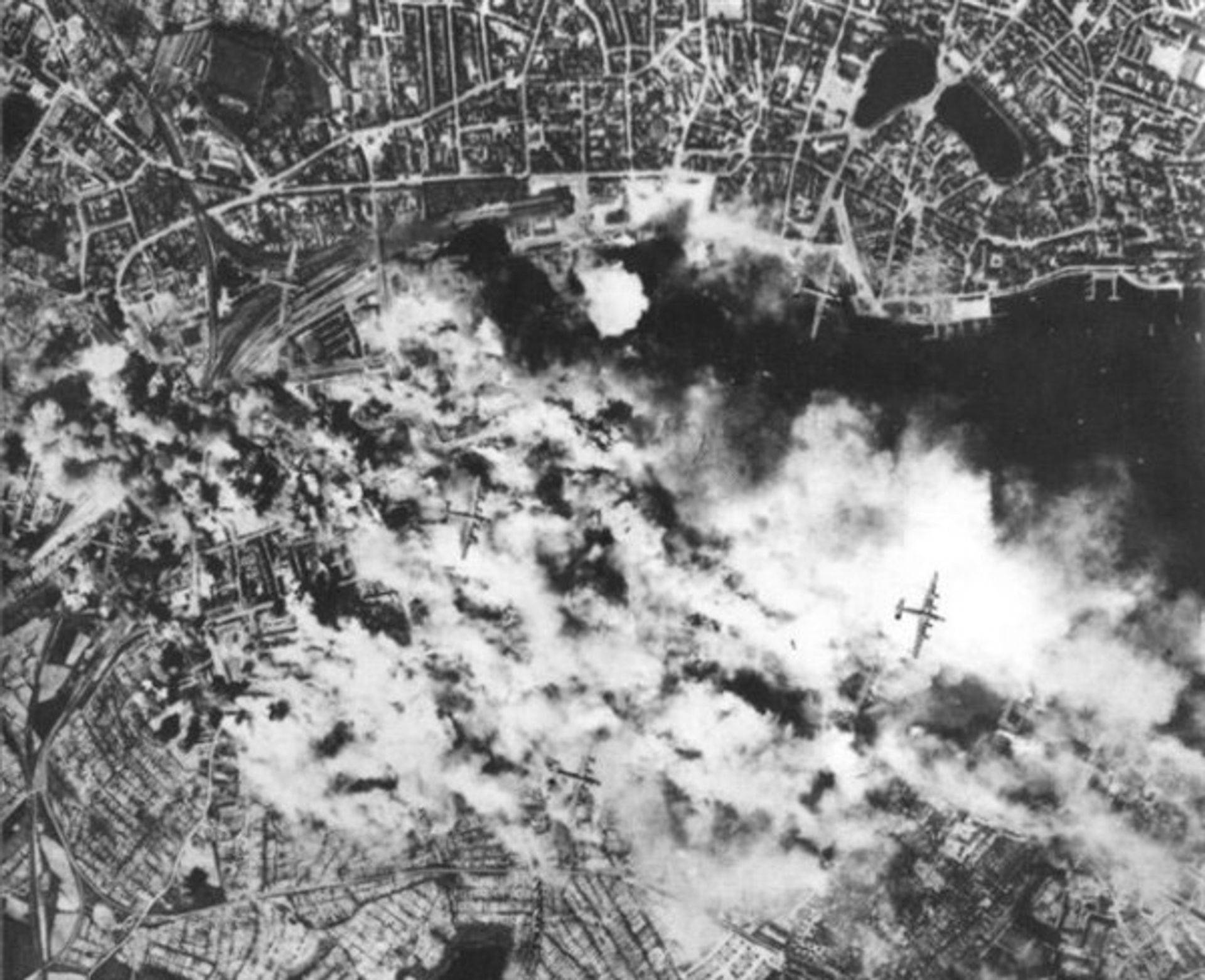
Undated photo of B-24 Liberators over Kiel, Germany
2Lt Henry H. Northrop – Pilot
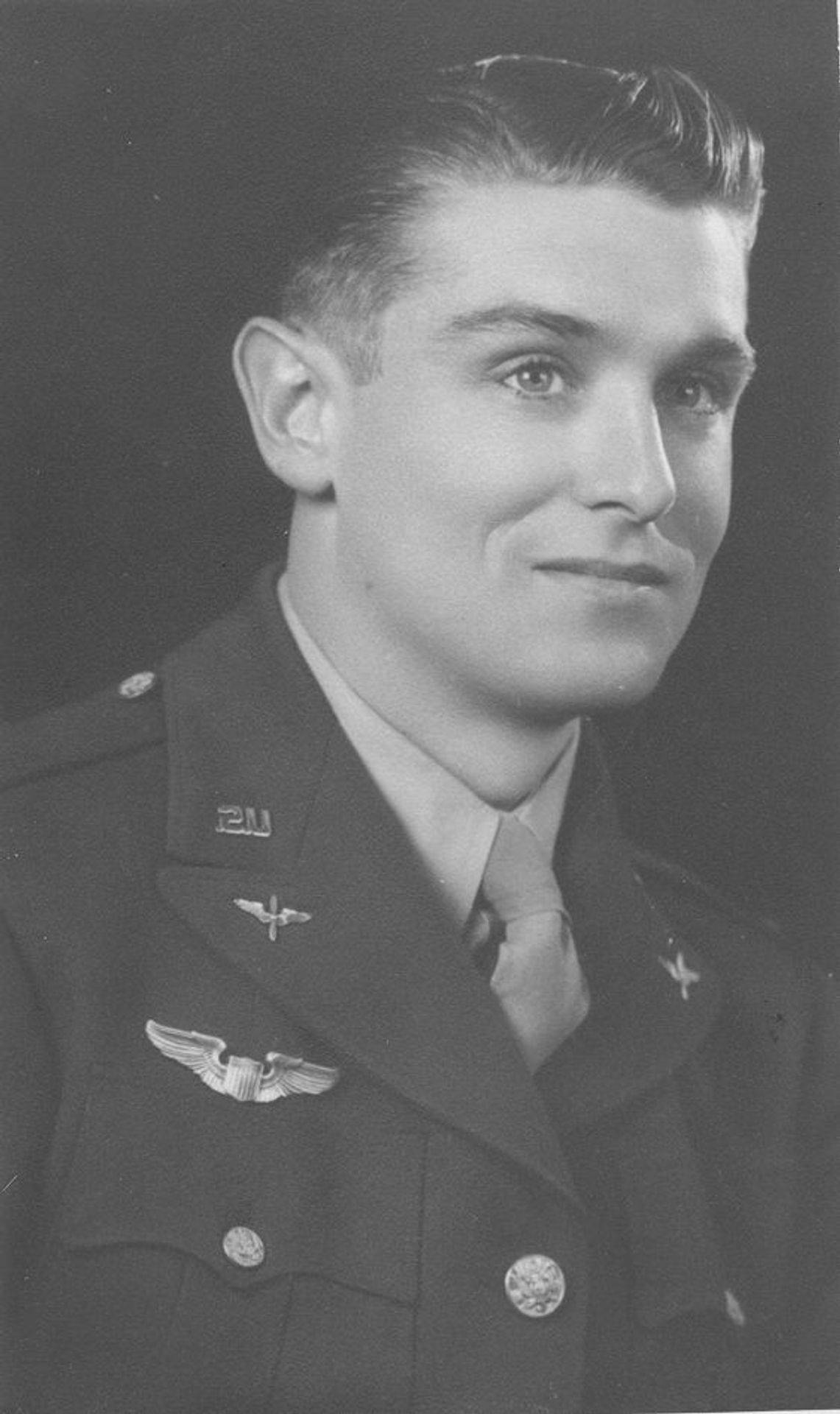
PILOT OF BIG BOMBER MISSING OVER GERMANY
Henry-Harris Northrop, One of Five Brothers Serving, Not Accounted for.
Went on raid June 18th
Craft Apparently One of 1,300 Which Participated in Big Foray on Refineries.
Pilot of a Liberator bomber, Second Lieutenant Henry Harris Northrop, 27, son of Mr. and Mrs. Harold Seal of No. 138 Bank Street, is reported “missing in action” over Germany.
Mrs. Seal was informed by War Department telegram that her son, one of five serving the nation, has been unaccounted for since June 18th, her birthday, on a flight over Germany. Associated Press reports for that day listed 1,300 heavy American bombers, operating from England, blasting oil refineries in the Hamburg area.
Flew Over City
Lieutenant Northrop flew his craft over Batavia on April 27th en route overseas. His mother had received letters from him written from Iceland and later from Oreland and he moved into action with the Eighth Air Force.
In his flight training career, the Batavia pilot seemed first destined to guide one of the Army Air Forces new Super Fortresses. He was in training with one of the giants at a Western base, but landing gear trouble resulted in his being taken off the B-29 and made first pilot of a B-24.
Others in England
Two older brothers were also last reported in England and are now believed taking part in the invasion of France. They are Captain Edward D. Northrop and Lieutenant A. C. Northrop while two younger brothers are in service in this country, Lieutenant Eugene A. Northrop at Camp Grant, Ill., and Sergeant Charles F. Northrop at Indiantown Gap, Pa.
Lieutenant Northrop received his wings and commission at George Field, Ill., last October from the twin-engine Army Air Forces Pilot School. He had entered training in February, 1943, and was schooled at Clarksdale, Miss., and Newport, Ark. Before donning uniform, Lieutenant Northrop was employed by the W. T. Grant Company in New York and had worked at Rippey’s Diner in Batavia.
Others in England
Two older brothers were also last reported in England and are now believed taking part in the invasion of France. They are Captain Edward D. Northrop and Lieutenant A. C. Northrop while two younger brothers are in service in this country, Lieutenant Eugene A. Northrop at Camp Grant, Ill., and Sergeant Charles F. Northrop at Indiantown Gap, Pa.
Lieutenant Northrop received his wings and commission at George Field, Ill., last October from the twin-engine Army Air Forces Pilot School. He had entered training in February, 1943, and was schooled at Clarksdale, Miss., and Newport, Ark. Before donning uniform, Lieutenant Northrop was employed by the W. T. Grant Company in New York and had worked at Rippey’s Diner in Batavia.

Henry Northrop’s POW identity card
Courtesy: Marilyn Jeffers Walton
1Lt William J. Brodek, 754th Squadron Armament Officer
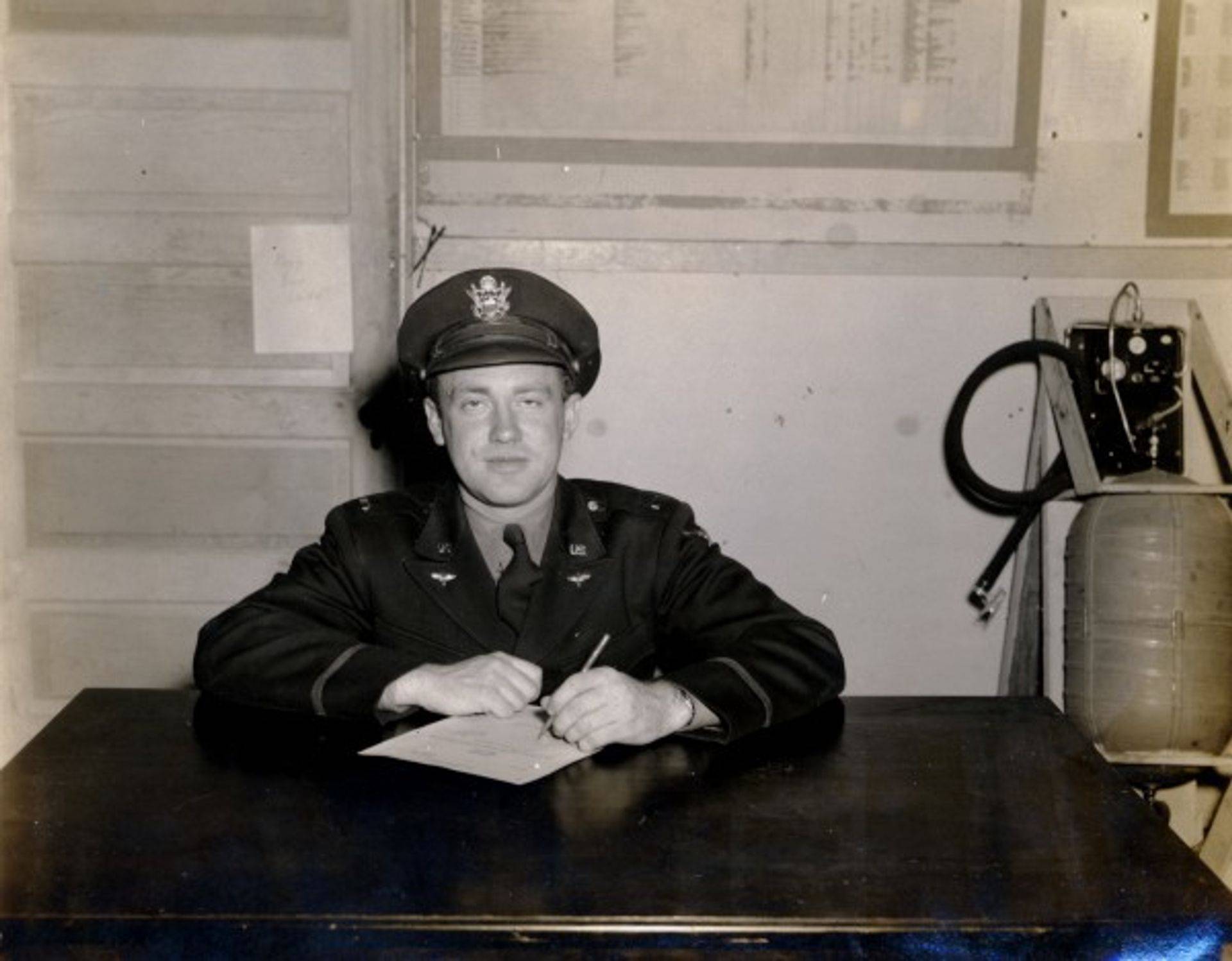
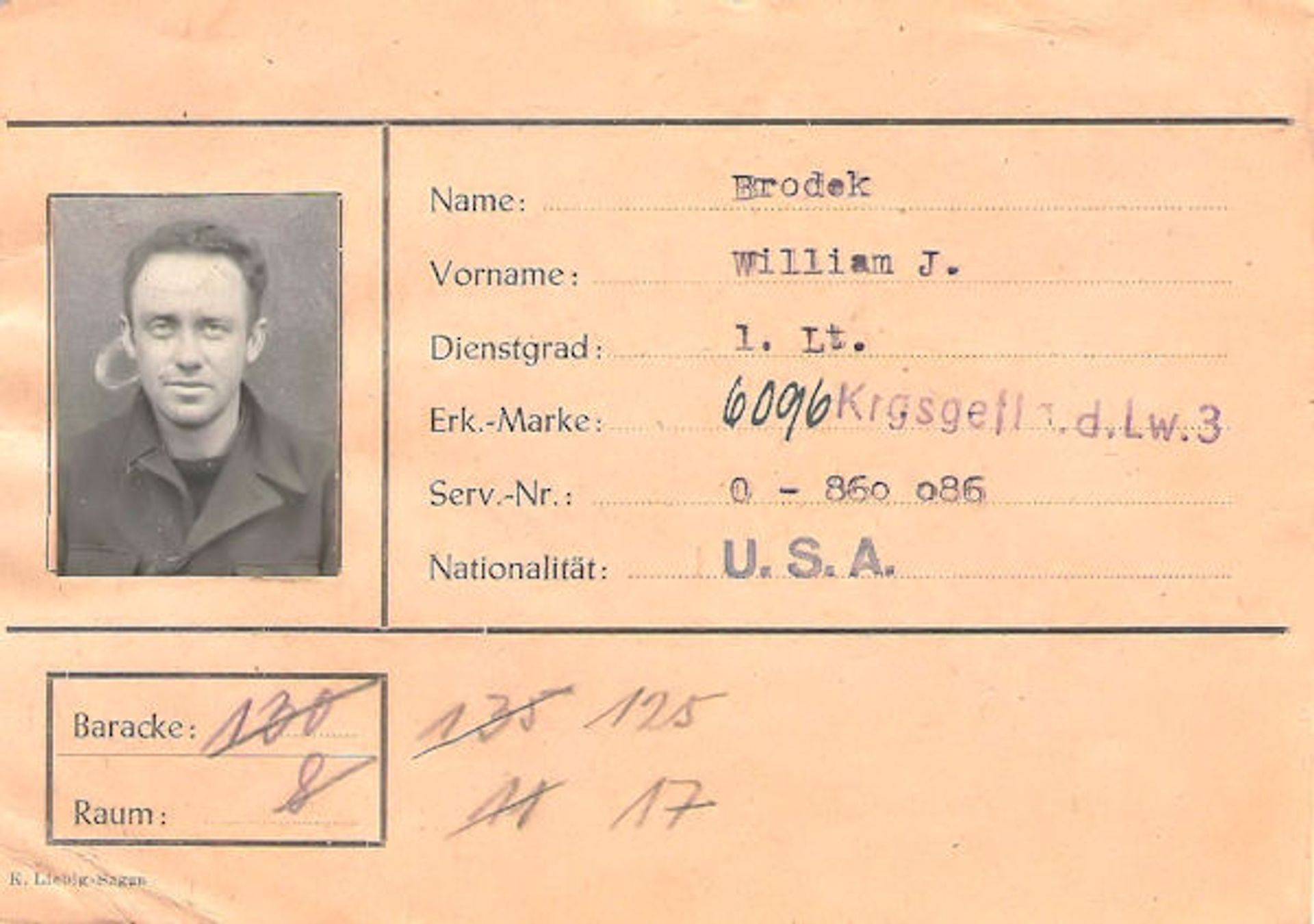

Courtesy: Marilyn Jeffers Walton
2Lt Dee Jack Butler – Co-pilot
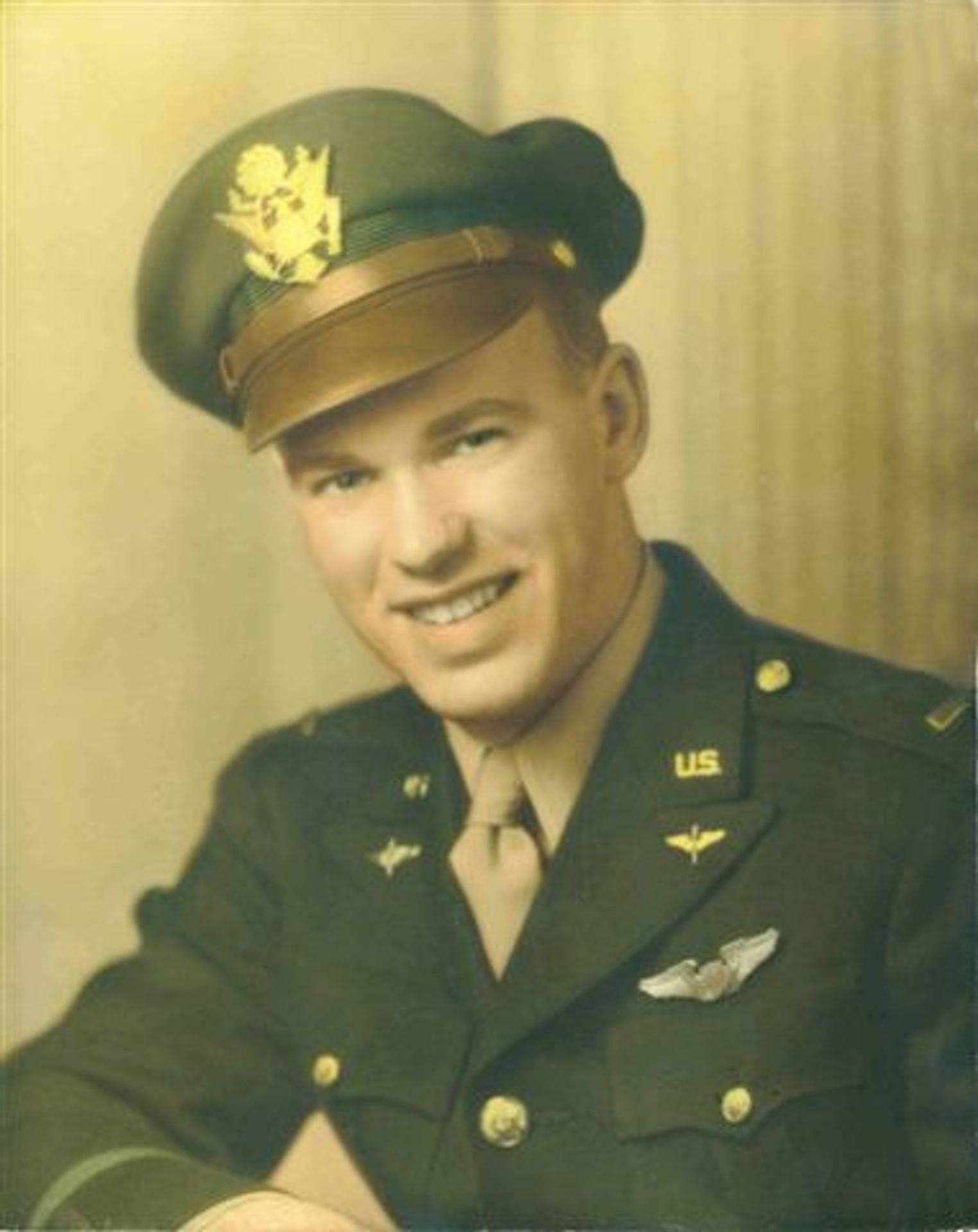
Dear Jeff and Phyllis,
We have been invited to be a part of your 50th. Congratulations on this milestone in your marriage! We, too, passed our 50th in June and were at a loss for the right descriptive power words. You two touched our lives for the better during those WWII perilous trials and sacrifices.
While receiving our B-24 crew phase training at Casper, Wyoming, I remember your picking me up half frozen on a designated corner in town in your air conditioned jalopy for another duty day at the base. Like you two, Miriam and I were also living in town. Occasionally we all got together for dinner out. It was nice to get away from the military way.
Next came a struggle for our lives for Jeff and me and for the lives of our entire crew while on a combat mission over Germany. Our B-24 was scheduled to drop incendiary bombs and in the process, one of the bombs stuck in the bomb bay. The bomb was armed and ready to explode anytime. The entire B-24 could have exploded too. Jeff and I didn’t have time to calmly think out a solution. He and I located a rope and Jeff was lowered to kicking distance of the bomb. A lifetime passed while he kicked time and time again and these efforts successfully dislodged the threatening bomb. Our B-24 crew didn’t know this was even going on.
When we were interned in Germany as POW’s, Jeff brought me great news when I needed it most. Phyllis had passed word that Miriam had given birth to a baby girl 12 days after our B-24 gave up the ghost on 18 June 1944 and was shot down. Hey, that was 48 years ago, the age of our daughter, Julie Anne.Our contacts with you two, even though brief, were enjoyed ‘cause we all needed each other. Thanks! Our posterity of 3 daughters, 17 grandchildren, and 3 great-grandchildren thank you too.
In loving friendship,
Dee & Miriam Butler
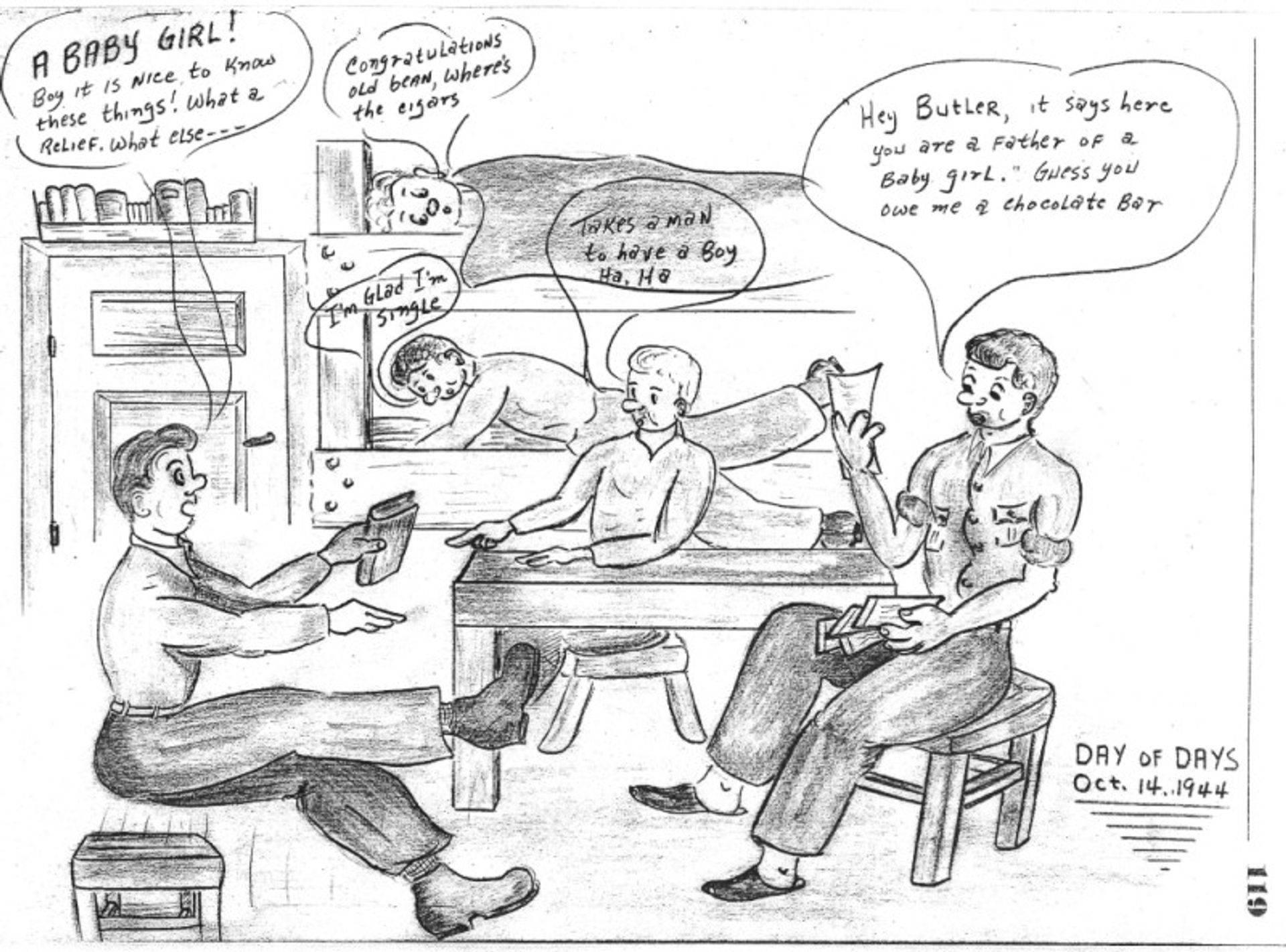
Dee Butler’s sketch from Stalag Luft III depicting the moment he found out he was a father.
Courtesy: Marilyn Jeffers Walton
“My Mission Record” S/Sgt Joseph F. Risko – Gunner

I. 6-6-44 – D-Day Normandy Invasion – Evreaux, France. Large airfield; Strong points on coast one hour before invasion. With my original crew Pilot – H.H. Northrop
(We bombed invasion coast of France one hour before our invasion forces landed. Our squadron 754 led the invasion bombing fleet. We saw hundreds of Allied ships and landing barges in English Channel. We gave the coast a terrific bombing. On the way to secondary target, and airfield in Evreaux, France, we had plenty of flak and 6 rockets shot at us. I saw huge fires in cities we passed near invasion coast. We had P-47, P-38 and P-51 fighter protection.)
II. 6-14-4 – Domleger, France. Supply depot & installations for pilot-less planes [V1 rocket]. Flak hit our ship in 3 places. With my original crew, H.H. Northrop.
(We smashed a secret supply depot and plane installation which turned out to be a pilot-less plane. Plenty of flak was shot at us. I also saw 3 rockets. We encountered no fighter opposition. My heated suit went out on me and I froze both my ears, right hand, and my left shoe had a short which slightly burned my foot. I was put in a hospital ward and grounded for six days. On the day I was put back on flying at 9:30 A.M. sick call, my crew went down on a raid to Hamburg, Germany. They left at 4:30 A.M. and an armament officer took my place. Reports say that 2 of crew airplane engines were on fire and they were headed for Sweden. No word from crew and they were officially missing. On June 21st, their personal belongings were sent home. I moved in with 6 other fellows, whose crews also went down.
III. 6-23-44 – Conde, France. Pilot-less plane runways & installations. No flak or fighters. P-51 area cover escort. With Lt. Hooven’s Crew
IV. 6-24-44 – Toussus/Paris, France. Large air training field, also hangars, field workshops, and runways on main field. No fighter opposition. P-51 area cover escort. Plenty of flak shoot at us one hit on ship. With Lt. Hooven’s Crew
V. 6-28-44 – Saarbrucken, Germany. Intersection of four railroad carrying troop reinforcements to battle of Normandy. Wiped out the whole works. Flew back over Belgium, France, and Holland. Saw another group bomb a huge airfield. Our tail gunner got hit in the back with a piece of flak. Saw (4) enemy planes, our P-38 & P-47 escort chased them off. 56 flak guns gave us pounding of our life. We had 23 fist-size hole all over our plane. With Lt. Hooven’s crew.
VI. 6-29-44 – Brunswick, Germany. JU-88 aircraft plant & the city of Brunswick. We destroyed the whole plant & started large fire in Brunswick. Saw Holland & Belgium. Our Navigator was knocked out by flak. Saw (40) enemy planes, but our escorts of P-38, P-47, & P-51s chased them away, shooting about (28) down. Our group lost two B-24s. I saw one crash & explode as it hit the ground. Three chutes opened, one on fire. The other plane had tail shot off & crashed. About 50 flak guns shoot at us. We got 9 holes in our ship. With Lt. Lamers(?)
VII. 7-6-44 – Kiel, Germany. U-Boat final assembly plant. We flew across North Sea to Kiel. Wreck plant. Saw large fires. Coming back we [flew] over Denmark, Germans laid smoke screen across a large oil refinery. No fighter opposition. We had P-38 fighter escort. Flak was very heavy. We got four flak holes in waist of our ship. Saw none of our planes go down. We had 136 flak guns firing on us. Flew with Lt H. Hopkins.
VIII. 7-7-44 – Lutzkendorf, Germany. Large oil refinery. We flew through France, Germany, Holland, Belgium. Completely destroyed target. We saw huge explosions & fire. Saw some smoke around 3 miles high over the clouds. We got some good pictures of the wrecked target. Around 100 fighters came up against us. I saw 14 and had a ME-109 in my Sperry sight. I couldn’t fire a shoot [sic] ‘cause our P-38 escorts took very good care of them. Flak was terribly heavy, we got 18 holes in our ship. Two holes missed me by a foot. Our fighters shoot [sic] down 114 enemy planes. We lost 36 bombers. I saw two of our planes go down. One on enemy territory & one in the sea. I flew my first mission with my new crew, called “All American”. Our pilot is Lt. Livermore.
IX. 7-12-44 – Munich, Germany. Marshalling Yards of 6 important railroads. We saw large fires. The trip was 10 hours long & was 1200 miles. Low cloud prevented seeing target, but smoke rose way above clouds. Radio says it was a devastating blow. No fighters arose to meet us. Flak was very heavy. We got 6 flak holes in our ship. On the way back we got lost in North Sea. We made emergency landing with only 40 gallons of gas. Our right wing plane was forced to land in Switzerland. One of our other planes went down in enemy territory. It was the 8th crew from Casper [Wyoming] to go down.
[Missions X – XIII ?]
XIV. 8/2/44 – Mont Louie Farme, France. We bombed P-plane launching site. Got some good hits & saw smoke 2 miles up. I rode tail turret, cause Moe finished his tour. Flak was heavy. We got 6 hits. The stuff was after our plane, but they couldn’t get us. Mission wasn’t too bad. I saw Dunkirk on the way back.
XV. 8/3/44 – St. Sylvestre, France. We bombed another of the German’s P-plane sites. It was hidden in some large woods. We found it & good, very good hits on it. Smoke rose very high. Flak was sorta heavy. No enemy planes fought us. Two [Nazi] planes followed us. But our escort chased them off. We flew over Belgium on the way back.
XVI. 8/4/44 – Bois De Queue Comtesse, France. We bombed airport. Completely destroyed its use to Germans. We got plenty of hits on runways and hangars. No flak & no enemy aircraft rose against us. Mission was very easy.
XVII. 8/5/44 – Brunswick, Germany. We bombed jet propulsion plane plant, army barracks, hangars, & assembly plant. We also bombed & destroyed Brunswick (Northeastern part) & the plane plant. We saw large fires & smoke up to 20,000 feet. Many explosions also. Flak was very heavy. We got 16 holes in our ship. We had one engine knocked out after bomb run. P-51 escorted us home. I saw four of our ships go down. We saw a dog fight between 25 fighters. Ours got 4 Jerries.
XVIII. 8/7/44 – Ghent, Belgium. We bombed oil refinery and storage dumps. The weather was bad so we had to bomb at 6,000 ft. Lowest we ever bombed. Us gunners strafed flak gun installations, trains, boats and truck convoys. It sure was fun. We hit our target and left it ablaze. Flak wasn’t heavy, but very accurate. Four fellows in our group got injured today. We got some hits, but damage was slight. Boy, I could see every flak gun shooting at us we were so low. I shoot [about] 1,000 rounds back at them. Sure hope I hit. No Nazi planes rose against us. I had tail position again.
XIX. 8/9/44 – Saarbrucken, Germany. I flew as bombardier on Lt Helfrecht’s [ship]. I dropped bombs & flew nose turret. We bombed the most vital German railroad marshalling yards. Our bombs mad direct hits on the yards & also hit the city of Saarbrucken itself. We could see fires miles away & smoke thousands of feet up. We carried 1,000 pounders & they really did a good job. We were also hitting the Stutguard [sic] area. Flak was very heavy & accurate. Germans also sent up fighters. Our escorts shoot down 38 of them. Flak got 4 of our planes. I saw about 26 men bail out. Two planes each flying on our tail were shot down. I saw 8 bail out of one & only one out of the other which exploded. The Germans had a field day with flak. Never saw so much in my life. Our ship got 18 hits. One piece stuck in my flak suit. Lucky me.
XX. 8/12/44 – Chalons Sur Marne, France. We bombed & completely destroyed a very important airfield. It was being used as a fighter base for enemy planes, used against our ground forces. We hit runways, hangars, & military barracks. Pictures show complete destruction of whole filed. We saw large fires. Flak was light at target, but they gave us a surprise party coming home. Flak was heavy over Belgium. We got 12 holes. Enemy fighter arose but our escort took care of them. We made an emergency landing at base, our gas was very low.
XXI. 8/13/44 – Front lines at Montfort, France. We bombed the main escape highways of the retreating German troops. We also bombed enemy troops with 100 Lb. anti-personnel bombs, who are trapped by our forces in France. Boy, we really paid those Germans a friendly visit today. It is believed that our bombs dropped on some 20 German trapped Divisions. We did a good job. Flak was very heavy. We got 7 holes. We saw 10 enemy aircraft but none attacked us. I saw 3 of our bombers go down & crash. Seven bailed out of one ship & only one out of the other. One bomber exploded in air, one broke in two from a direct hit, the other spinned [sic] & crashed to the earth. It was a very rough day & I really prayed. S/Sgt Epley finished his missions today.
XXII. 8/14/44 – Taveaux, France. We flew deep into southern France to bomb a very important German airfield. They were using it as a fighter base against the 15th Air Force in Italy. We knocked the field completely out. All the runways, hangars, workshops, & men’s barracks were destroyed. We saw large fires miles away. Today I saw the Alps & they were beautiful. Light flak & no enemy fighters. On take-off, in our own plane, our engines clunked out & we crashed into a wheat field. Lt Livermore did a good job handling the plane and no one was injured. We were badly shaken & had slight damaged to our ship. We took a spare plane & over target our turbos went on the bum & our oxygen was low, so we flew home alone. No planes attacked us & two P-51’s escorted us home. Lt. Livermore, T/Sgt Zitnak, & S/Sgt Cassidy finished their missions today.
XXIII. 8/24/44 – Hanover, Germany. We bombed & destroyed a large oil refinery at Hanover. I flew T.T. [Tail Turret] & saw large fires miles away. Black smoke covered the whole city. The whole area around Hanover was also bombed. Factories, oil ref., airfields, etc. we hit. I never saw so many large fires in my life or such large fires. Perfect day. Flak was very heavy & accurate. I never saw so much flak in all my missions. Flak covered an area of at least 15 to 20 miles. Heavy all the way. Enemy fighter[s] arose, but hit another group. They knocked a few of our planes down, but our fighters knocked many of them out of the skies. It really was a rough and long trip. Lt. Swartz flew as our pilot for the first time and did a good job. I flew Tail. I saw Belgium [and] Holland. We got 10 flak holes.
XXIV. 9/5/44 – Karlsruhe, Germany. We bombed Germany’s key rail marshalling yards. This opened the battle of the Siegfried Line. The yards were filled with cars loaded with vital supplies & fuel for Germans. We got direct hits on the whole works. I could see many explosions and fires miles away. Smoke covered the whole city. Flak was very heavy & accurate. We got 18 holes in our ship. No fighters came up. From tail I could see the cities of Stuttgart & Ludwigshafen burning. They too were well done away with. I saw fire & smoke a [hundred] miles away. All targets were completely destroyed. We flew over France’s battle areas & over the Siegfried Line. I saw Alps.
XXV. 9/8/44 – Karlsruhe, Germany. We bombed round houses, marshalling yard, & supply warehouse. We got perfect hits & caused many explosions & fires. I could see fires & smoke miles away. I also saw our fighters strafe flak gun emplacements & put many out of action. Other area targets were hit. Flak was very heavy & accurate. We got 9 holes. One as big as my fist went through fuselage a foot behind me. It was so close that I could see shells burst in front of me. It was very cold, 40 below, & I was freezing. Weather was bad & we flew in storm clouds up to 27,000 feet. It was a very long trip (10 hours). I saw Switzerland & the Alps. A few enemy fighters rose, but ours chased them away. We saw our Army in France. We flew over Paris & saw the city perfectly.
XXVI. 9/10/44 – Ulm, Germany. We bombed a tank & war truck assembly plant. The trucks and tanks are vital to retreating German armies. We got very good hits & should have destroyed whole of plant. Smoke rose to 20,000 feet & fires could be seen miles away. I flew Top Turret & saw about six other places burning. Flak was very heavy, but none got near us. Our escorts, P-51, P-47 shot down or destroyed 125 enemy planes. Flak was thrown at us from Siegfried Line. We flew over Paris & Brussels today. I saw our field hospital in France. It was very cold (41 below). I flew with Lt. Helfrecht as a substitute. Mission was very long. I went up with a slight head cold & got Aeotidus of the ears [possibly Otitis of the ear]. Spent night in hospital.
No credit mission, voluntary. 9/12/44 to 9/13/44 – St. Quentin, France. A secret mission. We had to fly gas from England to St. Quentin, France for our tanks in battle. We left our base here at 8:45 P.M. (9/12/44) and flew to Welford, England. It was very foggy and we had a terrible time trying to land. After missing a few other 24’s flying around with us, we landed in darkness. The base was a troop carrier base of C-47 cargo planes and gliders. It was a pre-invasion base for our paratroops. We landed there at 11:10 P.M. and slept overnight in q large gym with over 1,000 beds. In the morning (6 A.M.) we got up, had breakfast and helped load gas cans on our plane. We carried a 10,000 lb. load, much heavier than any bomb load we ever carried. We were told if any enemy fighter got on us to bail out without fight, ‘cause one hit on that gas would blow us sky high. After loading 240 cans of tank gas on our plane we took off for France.
We flew very low (900 – 2,000 ft.) I saw all of France we covered clearly. It was beautiful, except that every airfield, factory, marshalling yards & etc. were blown to hell by us. Every field I saw was full of bomb craters and a battlefield. France is really scarred up. We landed at a secret base, and there Frenchmen unloaded our plane. While that was going on, we stripped souvenirs off a German FW-190 which was shot down over the field the night before. I got 2 (20mm shells), 4(11mm shells) and a gas cap from the gas tank. I tried to get a swastika off the plane, but couldn’t. I talked with the fellows that had gone through the war so far and they told me all about their experiences in the invasion and after. It sure was interesting. A pack of cigs cost $10 down there. I gave a French kid a candy bar and he started thanking me in French. I didn’t understand him so I said, “It’s OK, pal.” The people welcomed us and even started to kiss us. Big time, we were. We took off for home at (2 P.M.) and got to base at 5 P.M.
XXVII. 10/6/44 – Stade, Germany. We bombed & got very good hits on the Von & Ross Aircraft Works. It was an assembly plant for the jet propulsion plane. Smoke & fires could be seen for miles away. The target was 7 miles from Hamburg & we got hit by its flak. Mission was 9 hours long & it was about -43 degrees. Flak was very heavy. We got 22 holes in our ship. One was a foot long. Enemy fighters arose, but our escort chased them away. We flew over enemy Holland and flak got us going in and out of it. It was very cold up there today. Two of our bombs got stuck, so I crawled out there in bomb bays and released them by hand. Flak was very heavy at the time & a piece smashed 2 feet away from me. I rode tail turret. I saw Hamburg on fire, bombed by other division.
XXVIII. 10/7/44 – Magdeburg, Germany. We bombed a vital oil refinery with 1200 pounders. The refinery was in [a] complete blaze after we hit it. I could see smoke up to 15,000 feet & many fires and explosions. It was estimated that the refinery turned out 50,000 barrels annually. We should of completely destroyed it. Flak was very heavy. We were in flak for 7 minutes at target. Many rockets were also shot at us. On the way back we ran into heavy flak at Brunswick and Hanover. Bruff’s oxygen hose was hit and he passed out. Clacko brought him to. We got 30 holes and Gorman found a piece of flak 5 inches long. It was about 45 below. Our escort was heaviest yet and they warded off a few hundred enemy fighters which were waiting for us. We flew over Holland and France.
XXIX. 10/17/44 – Cologne, Germany. We were supposed to bomb a vital chemical plant at Lever Kosn [sic], Germany if target was visual. The plant made vital war materials and chemical and poison gases. Since our target was clouded in we bombed the very important marshalling yards at Cologne. Cologne is situated in flak heavy Ruhr Valley. We bombed by instruments ‘cause the target was clouded in. We couldn’t see results, but the place was really hit. We used 500 pound incendiaries and 1000 lb. bombs. Papers say bombs hit with good results. The temperature was -38 degrees. Flak was very heavy and we got 8 hits in our ship. No one got hurt. We flew over Belgium, and over Aachen, Germany and France. Our target was 35 miles from the front lines at Aachen. Slight fighter opposition arose against us, but our fighter escort handled them perfectly. Our target was on the River Rhine.
[Missions XXX and XXXI ?]
XXXII. 10/30/44 – Hamburg, Germany. We bombed Germany’s largest oil refineries. We encountered very bad weather and had to bomb by instruments. We were at 27,000 feet and the weather was so bad, we couldn’t see the ships next to us. We pretty near collided twice. On the bomb run, Lt. Swartz did a wonderful job of blind flying. We couldn’t see bomb hits, but photo [reconnaissance] showed our 2,000 pounders did a good job of destruction. Photos showed large fires and very heavy damage to target. It was very cold (-48 degrees) and at times so cold that our windows had a 1/4″ of frost on them and we couldn’t see a thing. It was the worst mission I ever went on concerning weather. Flak was terrific and heaviest I’ve ever encountered. I really was scared too. All we could do was hear the stuff exploding around us and couldn’t see it. Once in a while through breaks [in the cloud] we could see many bursts of flak all around us. Our fighter escort was very good and only a few enemy fighters were reported in the area. They couldn’t of seen us anyway in that lousy weather and we the same. Lt. Swartz, Gorman, Clacko and Sgt. Foley finished their tour on this mission at 32. I still have three to go.
XXXIII. 11/2/44 – Bielefeld, Germany. We bombed marshalling yards with very good results. The target was clear and I could see large fires and explosions as we left target. The yards were one of Germany’s busiest, carrying troops and materials to front. The yards were crowded with trains. We sure gave the Heine’s a swell reception today. It was very cold (-44 degrees), so cold that my oxygen mask froze up. Flak was very heavy and very close to us. We got 10 holes in our ship. Enemy fighters arose and our fighters gave them battle. Our fighters beat them off after a few dog fights. Shooting 26. Nazi’s use their Jet jobs today. I flew with Lt. Gabriel (pilot) – Jackie’s crew. Tail position.
XXXIV. 11/4/44 – Misberg, Germany. We bombed Germany’s main oil storage depots. Crude oil welled at Hanover 5 miles away was refined and stored at target area. Target was clouded in so we bombed by instruments. Through breaks in clouds we could see our bombs hit target. I saw large fires and many explosions, smoke rose to 10,000 feet. Flak over target was very heavy and accurate. I never been caught in such a heavy flak barrage yet. We got 39 holes in our ship and our co-pilot was injured. Enemy fighters arose and we saw many dog fights. Our escort was great and did a good job of protecting us. It was pretty cold (-40 degrees). Jackie passed out ‘cause his oxygen hose froze up. One fellow on another ship died. His hose was shot up and he didn’t know it. I flew with Lt. Gabriel’s crew. We carried 2,000 pounders.
XXXV. 11/5/44 – Karlsruhe, Germany. MY LAST MISSION. We were supposed to bomb German pill boxes with 2,000 pounders near Nancy, France. The weather was bad, so instead of taking a chance of hitting our own troops, we bombed marshalling yards at Karlsruhe. We bombed by instruments and couldn’t see results. The temperature was (-49 degrees). Flak at target was very heavy and accurate. I really sweated our bomb run out and prayed hard. God answered my prayers and got us through safe. Flak was bursting very close to us and we got 26 holes in our ship. A few holes were in my tail turret, but none hit me. Enemy fighters arose, but our fighters drove them off. I shot at 3 fighters and got a probable to my credit. I saw the ship I hit on fire, but it disappeared and I didn’t see him go down.
I flew my last mission with Lt. Coode, our old co-pilot. Well, that’s the end of my missions and thank God I made it. I was the first man in our squadron and bomb group to complete thirty-five missions. Awards: D.F.C., Air Medal and 6 clusters, ETO Ribbon with3 battle stars, Certificate of Valor.
Coming back from my last mission, we ran into an 80 MPH gale over England. We were very low on gas and almost had to make a forced landing. Many planes did when their gas was exhausted. After being thrown around in the gale and sweating the rain and wind out, we made it back to our base. We were bounced around like a toy balloon over the sky and almost all of us were on the verge of air sickness. I was too scared to be sick. I kissed the ground after we landed and shortly after, went to the chapel to thank God for bringing me back safe.
The End.
Thank God I’m alive.
Courtesy: Marilyn Jeffers Walton
S/Sgt Harold Jack Flaugher – Flight Engineer

Sergeant Flaugher was the only casualty of the crew’s last mission. His body was brought to one of the shipyards in Kiel where the officers of the crew were brought to see him. At the time they thought that their crew mate had been the victim of German civilians, and after their release from POW camps at war’s end, related this information to the authorities.
A War Crimes Investigation was opened and the officers of the crew were questioned. Two supplied a letter to the Investigators and one was interviewed. The report does not mention whether or not anyone in Germany was ever questioned about the circumstances of Flaugher’s death, and it is most likely that no one was ever brought to trial on a War Crime.
The documents below were taken from War Crimes File No. 12-1900.
Letter to the Judge Advocate General’s office by Dee J. Butler:
Gentlemen,
Reference is made to your letter of 18 December 1945 relative to the death of S/Sgt. Harold Flaugher on 18 June 1944 near Kiel, Germany.
The information I have to offer is mainly the thoughts which came to my mind the first time I saw Sgt. Flaugher after I was captured by the Germans. All of our crew cleared the plane safely, and everybody’s parachute opened. It took the Germans about 2 hours to round all of us up, and to start us on the trip to a Stalagluft Camp. We were ordered into a truck and driven to a city, the name of which I cannot remember. At the time an ordinary black coffin was in the truck, but none of us thought much about it all being meant for one of the crew. However the truck finally pulled into a military installation which was definitely navy, and stopped before a long supply warehouse.
The guards ordered all of us into the warehouse and motioned towards a body lying on the floor with a covering over it. We hesitated long enough so that one of the guards who was impatient ran over and jerked the cover off. We then recognized that it was Sgt. Flaugher, and we could plainly see he was dead. The guard motioned to me to take off Sgt. Flaugher’s ring and dog tags, and also to take his parachute harness off. He used a chest chute, and the chute had already been detached from the harness. None of his legs or arms were broken, and the only sign of damage was a discolored area covering his right temple. His chest had also been crushed, but none of his clothes were ripped or torn, and the buttons on his shirt were still intact. We then put Sgt. Flaugher in the coffin, placed it in the truck, and buzzed away to the town cemetery.
The coffin was left there, and we were taken to a pooling center preparatory for shipment to the interrogation center. The other officers who witnessed the same thing belonged to our crew. They are Lt. Henry H. Northrop, Lt. Thomas F. Jeffers, and Lt, Frank Deimel. The Germans were quiet at the time we were removing the articles mentioned from Sgt. Flaugher. If Sgt. Flaugher had hit an obstruction before landing on the ground, I don’t see why his clothes were not torn or ripped; or why there were no broken bones other than his chest caved in and the bruised area on his right temple. I hope this information is sufficient, and I will gladly answer any request you may have
Respectfully,
Dee J. Butler
And by Frank C. Deimel:
Dear Sir,
With regard to your letter of 18 December1945 requesting information concerning the death of Staff Sergeant Harold Flaugher on 18 June 1944 near Kiel, Germany, the following is all that I am able to tell you.
Following our parachuting and being captured, we, that is all officers of our crew, were put on a truck and place under guard. There was a wooden box which the Germans used as coffins on the truck with us. We drove for some distance and finally arrived at what appeared to be a small navy yard. We were instructed to take the coffin and follow two officers who had appeared. We were led into a room which seemed to be a warehouse of some sort. There on the floor lay S/Sgt Flaugher. His head and chest were crushed although his parachute had successfully opened. What had happened all of us could only conjecture. He was dead when we found him and as far as we know there had been no violence. Upon taking his class ring from his finger and his watch from his wrist and turning these over to the German officers, we placed him in the coffin. After getting on the truck the Germans proceeded to pick up the other members of our crew. Then we were driven to a church with a cemetery attached where the body of S/Sgt Flaugher was left.
These are all the facts that I know with regard to the death of S/Sgt Flaugher. All else I would say is all conjecture. We know his chute had opened and he was all right as he floated to earth. What caused the injury to his head and the crushing of his chest, I do not know.
The others who were there at the time were: Lt. Henry Northrop (pilot), Lt. Dee J. Butler (co-pilot), and Lt Thomas Jeffers (bombardier).
Very truly yours,
Frank C. Deimel
Interview of Thomas Jeffers
For The WAR CRIMES OFFICE
Judge Advocate General’s Department – War Department
United States of America
In the matter of the killing of Staff Sergeant Harold Flaugher, United States Army Air Forces, which occurred at Kiel, Germany, 18 June 1944. Perpetuation of Testimony of Second Lieutenant Thomas F. Jeffers, Army serial number, 0-698015.
Taken at: 130 North Belmont Street, Springfield, Ohio
Date: 7 August 1945
In the Presence of: Clifford L. Currie, Agent, SIC, 5th SvC
Questions by: Clifford L. Currie, Agent, SIC, 5th SvC
Q: When did you enter the Army of the United States and state briefly the background of your Army career?
A: I enlisted in September 1942 and was called to active duty 27 June 1943. I was then sent to Sheppard Field, Wichita Falls, Texas; thence to Northwestern State Teachers College, Alva, Oklahoma; thence to San Antonio Aviation Cadet Classification Center. I was sent from there to Ellington Field, Texas for Pre-Flight training and on 13 November 1943, I received my wings at Big Springs, Texas. I was then sent to Casper, Wyoming for phase training and upon completion was assigned to the Topeka Staging Area. I was then sent overseas as a replacement in the 458th Heavy Bombardment Group. I was a bombardier in a B-24.
Q: When were you returned to the United States from overseas?
A: On 11 June 1945, aboard the Marine Dragon. I docked at Boston, Massachusetts.
Q: Were you a Prisoner of War?
A: Yes, I was captured 18 June 1944, and on 29 April 1945, I was liberated by the 14th Armored Division.
Q: Will you give the approximate dates you were held?
A: Well, I was captured 18 June 1944, in the suburbs of Kiel, Germany. I spent two days in solitary confinement at Schleswig, Germany, then I was sent to Frankfort, Germany for interrogation. After remaining there two and one-half days, I was sent to a permanent camp at Stalag Luft 3, Sagan, Germany where I remained from 27 June 1944 to 27 January 1945. I was then sent to Stalag 7A, Moosburg, Germany, arriving there 1 February 1945 and was here until 29 April 1945 at which time I was liberated by the 14th Armored Division.
Q: Do you have knowledge of the killing of any American Prisoner of War by the Germans?
A: No, but I have my doubts as to the cause of the death of Staff Sergeant Harold Flaugher, a member of my crew, who upon bailing out of the plane appeared to be in good physical condition.
Q: Will you explain in detail your doubts as to the cause of the death of Sergeant Flaugher?
A: On 18 June 1944, my plane was shot up over Kiel, Germany and no member of the crew was injured prior to the bail out order. Myself and three other Officers were captured when we landed in a small suburb of Kiel, Germany. We were then taken to the Kiel Naval Base and upon entering a small mine room we saw the body of Staff Sergeant Harold Flaugher, lying on the floor. Myself and three other Officers picked up the body and place it in a coffin. It is my opinion that Sergeant Flaugher was killed by a blow from some person or persons. His right temple was crushed and his chest badly mangled.
Q: Were there any Germans present when you and the three other Officers (members of your crew) placed Sergeant Flaugher in the coffin?
A; Yes, there were three guards who had brought us to the mine room and four other Germans who were dressed in the German Naval Uniform.
Q: What reason did the Germans give for the cause of the death of Sergeant Flaugher?
A: None spoke English, but when I ask in English if his chute had opened, one Naval official, shook his head and said no.
Q: Did you see Sergeant Flaugher’s chute open?
A: No, I did not. We left the ship about the same time and Sergeant Flaugher left by the front of the plane and I went out he back.
Q: Do you think any other member of your crew saw his chute open?
A: Yes, Lt. Dee J. Butler, might have seen his chute open. Lt. Butler pushed the Sergeant out of the plane at Flaugher’s request and he followed immediately.
Q: Where was Sergeant Flaugher when you next saw him?
A: Well, he had been picked up from his landing spot and I saw his body in the mine room at Kiel, Germany.
Q: Do you know of the approximate place where Sergeant Flaugher landed after bailing out of the plane?
A: No, I do not. We all landed in approximately the same area, but I never saw Sergeant Flaugher land.
Q: Did you inspect Sergeant Flaugher’s parachute upon reaching the mine room at Kiel, Germany?
A: Yes, to my knowledge it had opened. None of the lines appeared to have been fouled in any way and there was no blood on his chute.
Q: Did you inspect any of his other equipment?
A: Yes, When Sergeant Flaugher left the plane he was wearing his earphones and helmet. His right earphone had been crushed, but his left earphone appeared to be in good shape. His helmet was lying on the floor and I picked it up, but there was no blood on it.
Q: Do you know anyone who might know of the cause of Sergeant Flaugher’s death?
A: Yes. When we reached Frankfort, Germany our interrogation Officer, a German Captain by the name of Hermman (not certain as to name or spelling). Told me, “that it was too bad that we had to lose a member of our crew”. I would say that he would know the true circumstances surrounding the death of Sergeant Flaugher.
Q: Can you describe this Captain?
A: Yes, he was wearing a blue Luftwaffe uniform, about 5’ 10” tall, weighing about 150 pounds. He had a protusion type face and dark grey hair. His hair was straight and he combed it straight back on his head. I would say that he was at least forty-five years of age, because he mentioned being in World War I.
Q: Do you know of anyone else who might know of this Captain or who could give a description of him?
A: Lt. H. H. Northrop, I feel sure could tell you his name and give you a much better description than the one I gave. He spoke with this German Captain for quite some time.
Q: Do you know the present whereabouts of Lt. H. H. Northrop?
A: No, I do not, but his home is Batavia, New York.
Q: Did any member of your crew keep a record of this incident?
A: I don’t think so, we just kept it in our minds, but the Germans kept records at Schleswig and Frankfort, Germany, and I feel sure that they would have an account at one or the other of these places giving the details of Sergeant Flaugher’s death.
Q: Do you know of anyone else who might have information as to the death of Sergeant Flaugher?
A: No, I have already given you the names of the three American Officers who might have information as to the circumstances of Flaugher’s death.
Q: Do you know the names or can you give a description of any of the Germans who were present at the time you placed Sergeant Flaugher’s body in the coffin?
A: No, I do not know their names and I was too mad at the time to notice any distinguishing characteristics about them.
Q: What type of uniform were they wearing?
A: Well, as I have told you, four were in the German Naval uniform and the three guards who had brought us to the mine room were dressed in the Wehrmacht uniform. Two of these guards were about sixty years of age and both were privates. The other guard was an Obergefreiter and he appeared to be much younger than the two privates.
Q: Do you think that any of the other Officers who helped you place Sergeant Flaugher’s body in the coffin would know the names or descriptions of these German guards or Naval men?
A: Lt. Frank C. Deimel, might know the names of some of these guards because he spoke German, slightly. I do not recall whether he spoke to any of these Germans at this time.
Q: Do you know the present whereabouts of Lt. Deimel?
A: He will be at his home, 3317 Sheffield Ave., Chicago, Illinois until 15 September 1945. At this time he will report to Miami Beach, Florida.
Q: Do you have any further information relative to the incident to which you have just testified?
A: No, I do not.
Gretchen Bartel was a young German girl who witnessed the crash
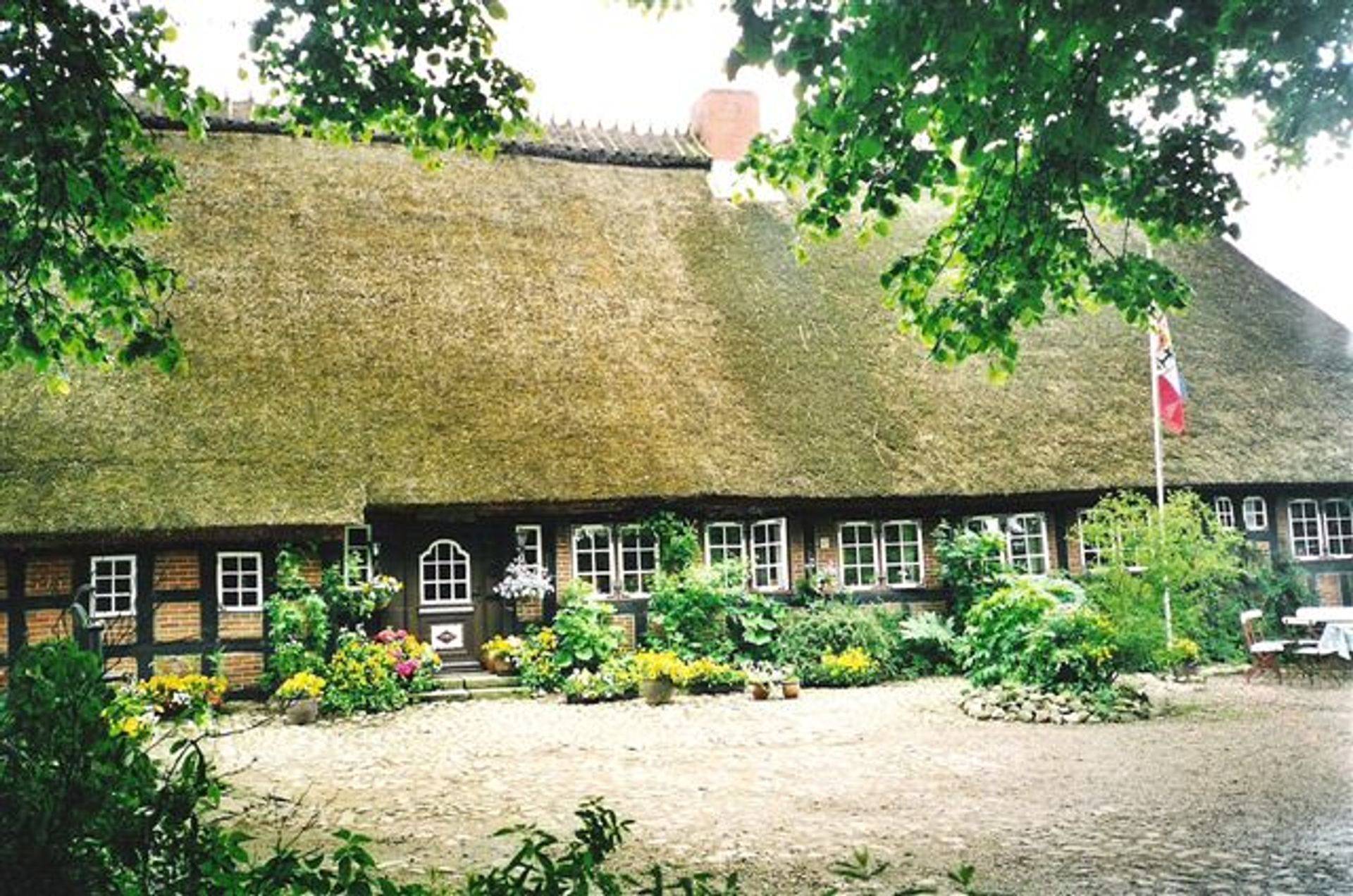
Bartel home, built in 1625
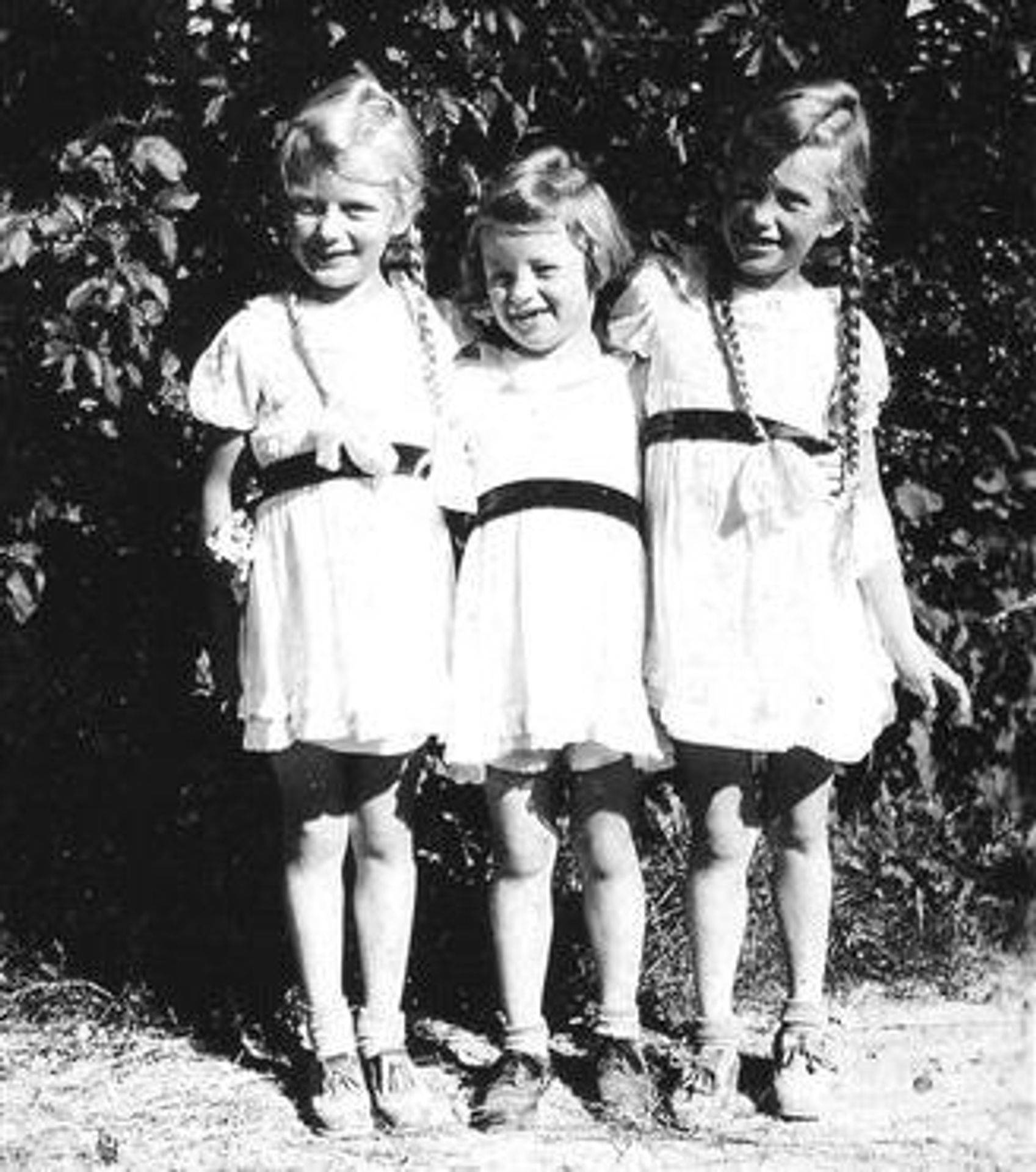
Gretchen Bartel (left ) with her sisters
“It was a Sunday morning when my sister heard the flak and shortly thereafter an airplane approached with a lot of noise. We stood at the back door of our house [pictured above] and looked with fear at the burning airplane. Directly above us the door of the airplane opened, and a man jumped out. The parachute opened, and he sailed above the big house in the direction of Braupholz. We could hear as the airplane dove and hit the ground nearby, and then it was dead quiet. Our mother was not at home. She was at church as were many of our neighbors, because it was Sunday, and there was a funeral service for Karl Hans Grot, whose airplane had crashed in Lithuania on May 14, 1944 during a training exercise. His brother Theodore had died in Russia in Aug. 1943. Three confirmed, Helmet Nissen, George Jensen and Kathi Hansen still remember the approaching crashing airplane. They thought it would hit the church. The man who jumped from the airplane with his parachute was unhurt and landed on Shlon-kjee Kier, which belonged to the farmer, Peter Trahn. The meadow next to that belonged to Nikolaus Claussen, and he was mowing. He approached the soldier and took him to his house and gave him some coffee to drink. Police officer Wittenburg from Norderbraup came and took the soldier prisoner. The prisoner was taken to Suderbraup, and then he was fetched by German soldiers. The plane crashed in a wood near Blick/Braupholz. It almost crashed onto the house of the family Ericksen who lived in Blick. The mother shrieked, “Get out, get out,” and they all threw themselves onto the ground. Her cows that were grazing on a meadow near the woods stampeded and disappeared in panic. They were seriously injured in the barbed wire fence.
“Our grandfather who was draining a meadow had to throw himself down to the ground. The burning airplane flew over his head. Grandfather Dietz was a master baker in Wagerschrott. As soon as he had time, he worked on our farm, as our father was a soldier in Norway. The burning 4-engine plane drilled itself deep into the floor of the forest. For quite awhile, we could hear explosions and saw smoke.
“My sister and I saw this later on too when we went to the crash site. It was a veritable migration to the crash site. Everything was picked up that was lying around—tin, aluminum and plexiglass. The crash site was secured and watched over by police and soldiers. A tent was erected where the guards slept. (This was reported by Eliza Ericksen.) The wreck of the airplane was totally dismantled. The four engines were dug out of the ground. When the guards left everything was gathered lying around aluminum strips, etc.
“The plexiglass of the pilot’s cabin was used for jewelry and for magnifying glasses. The father of the refugee family living on the Ericksen farm used the plexiglass to make bowls and other kitchen gear. The planes that flew attacks on German cities (Kiel) originated in England. Our area was transversed on the way back to North England. That’s why several planes crashed here. The plane which crashed in Blick was shot down by flak in Barklesbee.
“There are crash sites in Blick and other cities. On the north grave yard in Kiel are many solider (military graves partly with name and date of death). The crash site in Blick you can still see today. You can see the four indentations which the engines left. Ernst Hansen showed us the crash site. It is the forest that belongs to Thiesen Rugge. At the one end of the forest is the Bruckner house. Still many people left today can talk about the crash. There are those who are 70 years old, FO Jahninge, Ernst Hanse, Hans-Ludierg Peterson, and our current mayor, George Hansen.”
Courtesy: Marilyn Jeffers Walton
Rhapsody In Junk
A Daughter’s Return To Germany to Finish Her Father’s Story
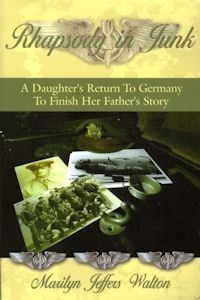
Marilyn Jeffers Walton, daughter of the crew’s bombardier, has penned an excellent book about her father and his crew. Her painstaking research has brought many details to light regarding the loss of the crew and the death of their Flight Engineer. She traveled to England, Poland, and Germany visiting the site where the crew’s plane came down and spoke to several people who were there at the time. The friendships formed over these several months of research and her trip to Germany will last a lifetime.
Marilyn is also heavily involved in preserving the history of Stalag Luft III, where her father and the other officers of the crew spent the next several months as Prisoners of War. She, along with several other children of former Stalag Luft III POWs, took part in a recreation of the march from Sagan to Spremberg, covering the same route that the POW’s marched in January 1945 when the Germans evacuated all of the prisoners ahead of the Russian advance.
The majority of the material on this web page is due to Marilyn’s research, for which I owe her a big, “Thank you!”
Available at Author House and Amazon
Crash site of Rhapsody In Junk



Pieces of Rhapsody in Junk found at the crash site, January 2008
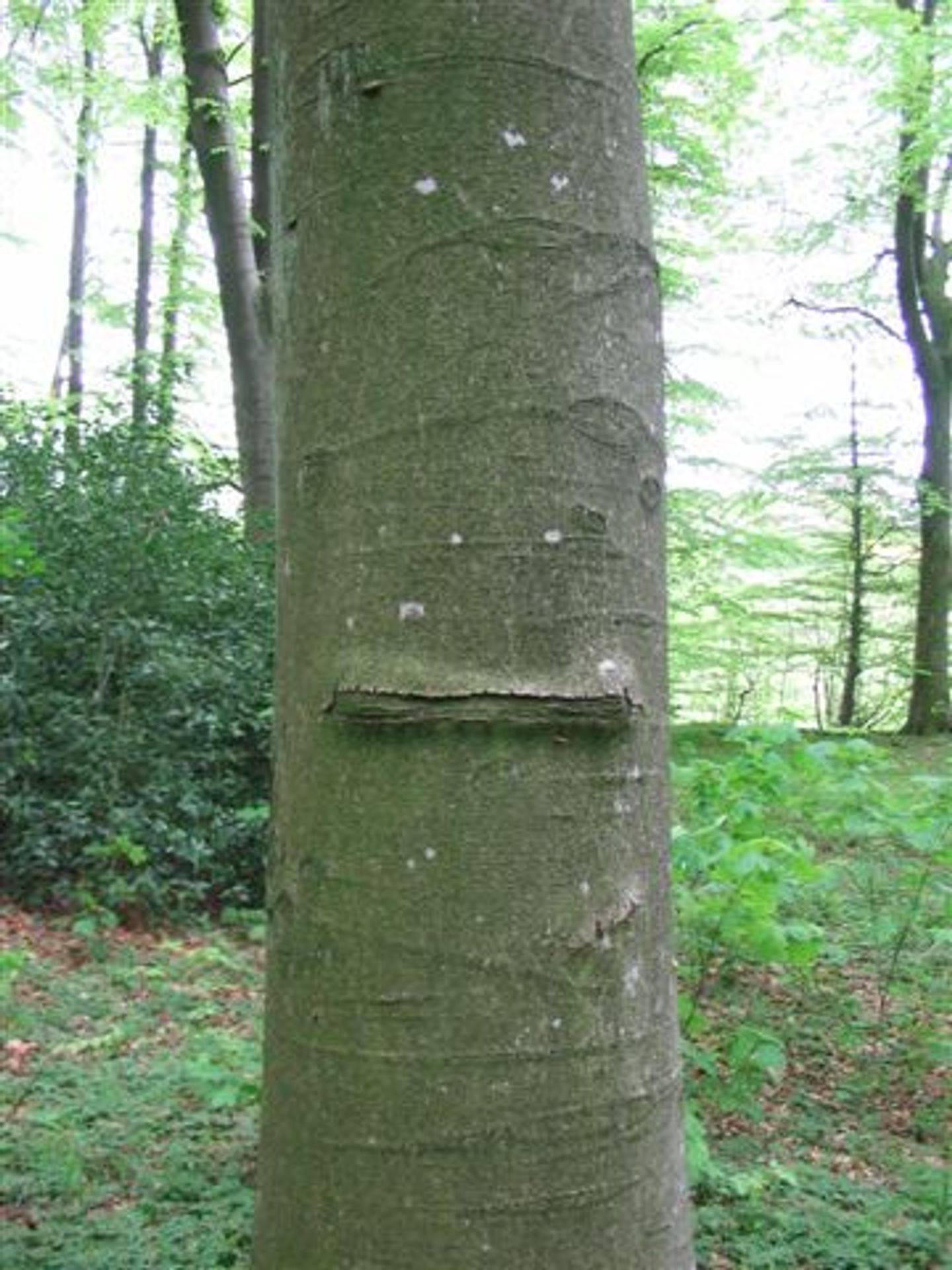
Tree still bears the mark where a part of the plane hit it.
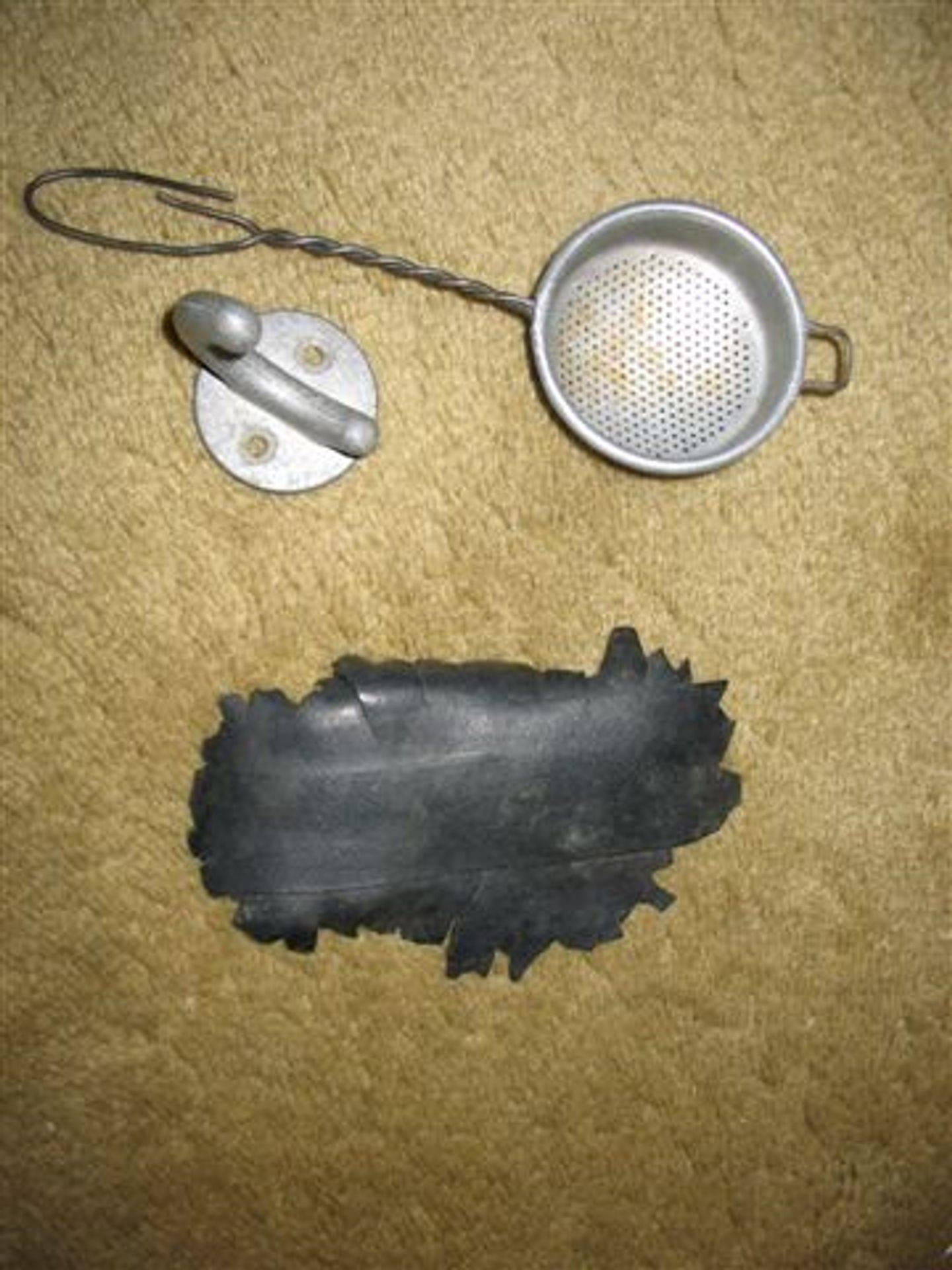
A piece of a tire; and a coat hook and strainer made by local Germans from the aluminum of Rhapsody in Junk.
(Photos: Marilyn Jeffers Walton)
Rhapsody in Junk II – Baghdad, Iraq – 2007


